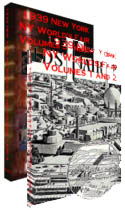Archive for the ‘Amusement Parks’ Category
While Mardi Gras history is one of those legends that remains unsettled to this day, this is the most common story.
 In 1829, several young men returned from a visit to Paris back to their home town of New Orleans, Louisiana. While in Paris, they fell in love with a lively French custom and made efforts to bring this custom to New Orleans. They dressed in costumes and masks and paraded through the narrow streets of the French Quarter of New Orleans. People saw them and became excited by the spectacle. More people joined and followed them until they caught the attention of the ladies of the town, who leaned over their balconies and threw chocolates and kisses to them. From that time on, masked walking parades became fashionable in New Orleans in the springtime.
In 1829, several young men returned from a visit to Paris back to their home town of New Orleans, Louisiana. While in Paris, they fell in love with a lively French custom and made efforts to bring this custom to New Orleans. They dressed in costumes and masks and paraded through the narrow streets of the French Quarter of New Orleans. People saw them and became excited by the spectacle. More people joined and followed them until they caught the attention of the ladies of the town, who leaned over their balconies and threw chocolates and kisses to them. From that time on, masked walking parades became fashionable in New Orleans in the springtime.
Over the years, the festivals became more organized and elaborate. In 1857, a group of people calling themselves “The Mystick Krewe of Comus” made their way through the streets on floats pulled by horses. One float was carrying the king of the Krewe on a throne and another carried a devil sitting among flames made from paper and representing hell.
In 1872, a person of true royal blood found his way into the festival. Alexis Alexandrovich Romanov, the brother of the heir to the Russian throne, visited New York and fell in love with an American actress named Lydia Thompson. He followed her to New Orleans, where the Mardi Gras was being planned. When the planners discovered that a royal person was attending the noisy festivities a float was added for a new king, “Rex.” (Thus was born the Krewe of Rex – an important cornerstone of the history of Mardi Gras.)
That year set the pattern for the boisterous fashion in which the Mardi Gras is celebrated today. Purple, green and gold became the official holiday colors. The Grand Duke Alexis was surprised and honored to sit on the float and play the role of Rex. Alexis and Lydia probably never even met, but they began a tradition. Rex and his queen are chosen each year to ride on the largest float. They are masked and in costume. Those around the royalty, called “maskers,” toss “throw-outs” to the crowd in response to the traditional cry, “Throw me something mister!” The “throw-outs” are large tin coins, plastic beads and other trinkets.
The holiday had become a full carnival by the time Alexis participated. The word “carnival” comes from the Latin and means “take away the meat.” It is a time of merry-making and intense fun because “Fat Tuesday” is the last day that Catholics can eat meat before Lent. “Ash Wednesday” officially marks the beginning of Lent, the forty-day period of fasting before Easter. Lent comes from the Anglo-Saxon word “lengten-tid” (a lengthening time).
Sun Valley in the amusement zone at the 1939 NY world’s fair was a truly magical place.
This winter wonderland, one of the largest village concessions in the amusement area features fancy, speed and novelty skating on the disappearing ice rink, tobogganing on a slide with a 45 foot drop, and spectacular leaps from a lofty ski jump. In addition, a toboggan slide 160 feet long comprises several banked turns and thrilling dips. The scene presents a panorama of fir and pine trees amid rock formations that represent the foothills and surrounding mountains, while the illusion of reality is heightened by a 40 foot waterfall cascading down from the topmost cliffs. Visitors are permitted to clamber up the rocks and survey the quaint village beneath them which is Alpine in structure with snow blanketed houses, stores, and the church, clustered around an oval mill pond. Here Liebmann Breweries of Brooklyn sponsor the restaurant facilities Rheingold Inn, Rheingold Terrace and several Rheingold Taverns. A nearby ski jump is reserved for professional skiers, while the mill pond serves as an ice rink with 30 minute shows given 12 times daily in the open air. Music is furnished by a 15 piece orchestra supplemented by a $25,000 pipe organ; wandering musicians, singers and your yodelers performed in the village streets; shops display Alpine novelties and confections; other features include a cuckoo clock tower, and a stork tower with real storks. Here, throughout the summer, a snowstorm is realistically depicted every evening.
The 1939 Worlds Fair was financed primarily by private enterprise. While the fair definitely depended on government action to be constructed, etc., not a penny of public money was used in its construction and operation.
The organizers of the fair created the Fair Corporation, a non-profit entity to raise money for the construction and operation of the fair. After a careful study, they estimated that the cost of the fair and all the related improvement projects would run approximately $150 million dollars. A large portion of this money was invested in general infrastructure in New York – roads, sewers, bridges, etc. and was spent by the city as an acceleration of projects already planned for city improvements. The cost of these improvements to the city of New York (and paid by the city of New York) exceeded $20 million dollars.
Various government entities around the workd invested over $30 million for various exhibit buildings and exhibits at the fair and the Fair Corporation invested approximately $42 million dollars on the fair. Additionally a bond issue raised $27,829,500 to help with other aspects of making the fair a reality.
As you can see, that was quite an expensive undertaking for a country in the depression. As an interesting side note, it is believed that the activities surrounding the fair resulted in the circulation of approximately one billion dollars – revenues sorely needed by the businesses of New York City at this time. These acitivities include things like lodging for the guests, food and merchandise bought both at the fair and in New York City, transportation costs and all the other related revenue streams created by any large event.
However, from a financial point of view, this the worlds most famous fair, was a failure as when all the dust cleared, the Fair Corporation lost money and was forced to go into bankruptcy after it was all over.
The 1939 New York World’s Fair had a variety of admission options – both presale and ongoing. It is interesting to notice that they had packages much like modern day Disney does. Here are the various admission options that were available at the world’s fair.
Advance options: There were two advanced ticket options for the 1939 Worlds Fair.
The first one was a special Souvenir Book of tickets which contained 5 tranfserable general admission tickets and six concession admission tickets. The retail proce of the Souvenir Book was $5.40 and the advance price was $3.75.
The second option was a non-transferable twenty admission ticket option with the person’s photograph. This option had a value of $15 and was sold for $7.50.
General Options: While the fair was operating, there were several ticket options that one could utilize.
The first was a one time general admission ticket. It cost 75 cents for adults and 25 cents for children between the ages of three and fourteen. And for one day each week, children could get into the fair for 10 cents.
The second option was a season ticket. Season tickets had the owners photograph attached to them and cost an adult $15 and a child $5.00. College students and school teachers could purchase a season ticket for $7.50. Seasonal tickets allowed the ticket holder into the fair as many times as desired.
General admission tickets allowed entry at any one of the ten entry gates and allowed you to walk the grounds and explore the more than 100 general exhibit buildings which housed thousands of exhibits covering the entire spectrum of human achievement.
The 1939 New York World’s Fair was a remarkable place that drew huge crowds during its existence. It resonated with the people of New York and of the world at a time when the world was still weary from World War I and the great depression and didn’t want to hear about the rumblings of World War II.
 In spite of the planners best efforts for an enlightened event, they couldn’t fight the need of the masses for fun entertainment. As a result, the amusement area was the biggest hit of the fair – which surprised the planners as it was just thrown in there because fairs needed amusement areas. It was not a highly organized affair like the exhibit zones were.
In spite of the planners best efforts for an enlightened event, they couldn’t fight the need of the masses for fun entertainment. As a result, the amusement area was the biggest hit of the fair – which surprised the planners as it was just thrown in there because fairs needed amusement areas. It was not a highly organized affair like the exhibit zones were.
One of the great pasttimes of fair goers was the dancing that went on in the amusement zone. It was so popular that even as the NY World Fair was winding down, they were still promoting the dancing at the fair in the streets of New York including Wall Street and they brought out the big guns like Mister Bo Jangles tohelp in the promotion.
This video clip captures the fun of the dancing at the fair and in the streets of New York during that time.
[youtube width=”350″ height=”288″]s4xggfNWxdc[/youtube]
